On the 04/12/2020 approximately 100 people stood in the middle of Syntagma square (i.e.: Constitutional Square, in front of the Greek parliament) in the center of Athens, Greece, while holding a banner with the following sentence written on it:
“These days belong to Alexis”

Who was Alexandros Grigoropoulos?
The fact that this incident took place in the middle of the CoViD-19 pandemic in correlation with the well-known violent tactics of the Greek repression forces raises a very logical question to every person that is unaware of its history: Who was the aforementioned ‘Alexis’ and why did these people find it necessary to demonstrate, putting the importance of memory before their own health, in a country that faces the deathly consequences of the Mitsotakis regime and its inadequate, corrupt, and fascistically militant approach on people and the pandemic?
Alexandros Grigoropoulos (Αλέξανδρος Γρηγορόπουλος 25/06/1993 – 06/12/2008) was a greek anarchist student who was shot and murdered by special guards (untrained(!) police officers, originally with duties as guards of important people and places and pure crime repression, but meanwhile with the same duties as every other police officer, apart from leading invastigations) Epaminondas Korkoneas and Vasilios Saraliotis (Επαμεινώνδας Κορκονέας, Βασίλειος Σαραλιώτης) in Exarcheia, central Athens. He was there with some of his peers to celebrate the nameday of his friend Nikos Romanos (Νίκος Ρωμανός).
The Night of the Murder
12 years have passed from the night that Alexis’ life was viciously and violently taken by the hands of Korkoneas and with the complicity of Saraliotis. During this time period there have been many publications, independent or not, that attempted to form a precise and truthful portrayal of the chain of that night’s events. We as FYTILI (“WICK”), however, would like to present the incident with the words of Nikos Romanos himself, as published on the Athens Indymedia website on 05/12/2015.
The following is nothing but a translated excerpt from Nikos Romanos’ depiction of the murder of his friend. The original and whole text is in Greek and can be found here. The translation isn’t official. We tried to form an English version of the original, while strictly following the style and chain of thought of the writer. We urge any Greek English-speaking readers to contact us for possible improvements.

“The next frame of the presented narration is the cursed night of the 6th December. I (Nikos Romanos) was sitting, together with Alexandros (Grigoropoulos) and some other children on the pedestrian Mesolongiou Str., like we did on an almost daily basis. After a while, a comrade came and suggested that we head towards Charilaou Trikoupi Str. to wait for a police patrol vehicle to pass, in order to throw some rocks that he had already gathered, at it. Korkoneas’ and Saraliotis’ patrol car passed by later. Indeed we went and waited, while Alexandros was sitting further back.
Without me realizing it, the fullness of time had come for all of us, it was the moment that would change everything. Life’s hourglass turned the very moment the rock was falling on Korkoneas’ patrol car. Then we returned (to Mesolongiou Str.) and sat on the pedestrian street with the other children, while Korkoneas and Saraliotis drove through Zoodochou Pigis Str. to acknowledge the people that attacked them; Some small objects were thrown by us at the patrol car there, (and) after they recognized our company they parked the patrol vehicle near a platoon of Units for the Reinstatement of Order (MAT) that was guarding the offices of the Panhellenic Socialist Movement (PASOK,Social-Democrat Party) and walked to the junction of Tzavela and Zoodochou Pigis Str..
The second we saw the cops we stood up in order to go away, because we thought that the MAT platoon would accompany them, as it usually happens in such cases. That moment the two cops started cussing and then we noticed that they had come on their own, without any supporting police force. Some of us moved towards them and Alexandros, who was already in front threw some of the beer bottles we were drinking at them. In the following seconds Korkoneas took out his gun and, with the use of bullets, put an end to this specific confrontation that had just started.”
Furthermore, different witnesses specify that Korkoneas shot twice and was clearly aiming at the group of children in front of him. The two special guards then calmly walked to their vehicle and fled and reported the incident.
L.V., a local, having witnessed the beginning of the incident, was able to capture the return of the police officers to the scene, as well as the moment of the murder on camera. She was the one who showed the position of the two policemen to the investigators and contributed to finding the bullet cartridges. This contribution, however wasn’t enough for the Investigation to call her for testifying. It was only much later that she was called to court by the lawyers of Alexis’ family.
The first reactions
The events that would be later known as the ‘Black/Greek December’ started almost immediately after the murder. The word that a young boy was shot with plastic bullets by police spread like wildfire throughout the Athenian movement – be it by word of mouth, via the Athens Indymedia website or other means. After a while, and since Alexis’ death was announced, it was clear to everyone that the bullets were not out of plastic and that state force had committed a vicious and violent crime. The first barricade fires were lit, and some riots occured in the same night, mostly near the historical building of the Polytechnic University. The tensions then moved from Exarcheia over to Evangelismos General Hospital, where Alexis was admitted after he was shot.
On the side of the ‘Liberal Democracy’, the deputy minister of the interior, Panagiotis Chinofotis (Παναγιώτης Χηνοφώτης), ordered the two officers involved in the murder as well as the commander of the Exarcheia police station be suspended, before filing his resignation along with his superior, minister Prokopis Pavlopoulos (Προκόπης Παυλόπουλος). Both resignations were not accepted by Prime Minister Kostas Karamanlis (Κώστας Καραμανλής). Various state officials expressed almost directly their unanimous condolences to Alexis’ family and the condemnation of the incident.

Yet the morning of the 7th December found Athens and other major Greek cities filled with students and people protesting to demonstrate their disgust for the murder and their indignation towards police and state violence in general. That was the moment when state and systemic press realized that, in order to get a grip on the situation, they had to disparage the murdered minor and present him as part of a violent and massive mob rioting and attacking the two policemen, who then apparently acted in self-defense. In this manner MEGA, a major tv station at the time, aired in the main evening prime-time newscast the aforementioned video submitted by L. V.. The video was shown many times during the report and at some of them its audio had been manipulated by adding demonstration sounds to it, so that it looked like Korkoneas and Saraliotis were facing a raging mob. Christos Panagiotopoulos (Χρήστος Παναγιωτόπουλος), then news manager of the station, stated three years later:
“Unfortunately, everything went wrong. We shared a distorted version of the only video-document from the moment of the murder. Sounds of demonstrations and breaking shop windows had been included, before Korkoneas’ murderous shots were heard. Thus, someone could reasonably believe that violent incidents preceded and, therefore, Korkoneas found himself in defense! […] I was absolutely shattered. On the one side I had to manage my son’s grief (editor’s note: Alexis was his friend) and on the other side to apologize for the supposed support of Korkoneas.”

But the later remorsed Panagiotopoulos was not alone back in the day; mass media reported mostly based on information they got directly from police officials and focused on the riots and material damages that happened alongside them. In addition, it soon became apparent that the media were hiding evidence of the murderous behavior of the police even after the night of the 6th. For instance, a highly important photograph shot by Kostas Tsironis (Κώστας Τσιρώνης) for the newspaper ‘Ελεύθερος Τύπος’ (=Free Press), showing two policemen threatening demonstrators, the one forming his hand as a gun and the other one pointing at them with an actual gun and firing warning shots, did not get published. Tsironis, forced by his journalist ethics, made the photograph available for the foreign press, which published it immediately, leading to his dismissal from the paper for breaching exclusivity.

On top of that, a seemingly orchestrated defamation campaign against Alexis was launched. From falsely reporting that he had been expelled from his school because of ‘unmannerly behavior’, to assuming he showed his genitals to the policemen, every nuance of the spectrum was represented. An always recurring narrative was that Alexis was a ‘spoilt rich kid, acting out his revolution off of daddy’s money’. In the same time the excuses for the perpetrators were plenty. From their ‘previous honorable and lawful life’ through them ‘acting on duty’ to the misleading assumption that Korkoneas was not directly pointing at Alexis, thus the bullet first hit the ground and diverted to Alexis – all of which were later deconstructed through either forensic or legal evidence.

This misrepresentation of the circumstances failed to intimidate the students and the movement; on the contrary, the rage sparked by this ghastly, cold blooded murder and the need to raise a clear voice against all fake news and bourgeois approaches to the situation led to massive solidarity and action. By the 8th of December many educational institutions and state offices across the country had been squatted and further demonstrations took place in almost all major Greek cities. Symbolic squattings and similar actions occurred in offices of the Greek state (embassies, consulates etc.) throughout the world. A prominent example was Berlin.
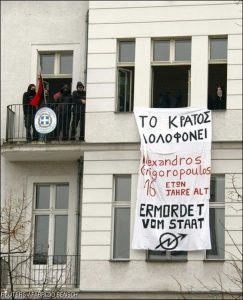
The vast majority of school students, having received the brunt of the shock of a fellow student being brutally murdered, took to the streets in unison, with grief, rage and a disgust for the vilification of Alexis and the indifference of the establishment and lead the demonstrations all over the country, while their schools were squatted or remained closed. Teacher and academic unions went out on strike, solidarising with their students. Extensive rioting took place in Athens city center, mostly directed toward symbols of the repressive power of capitalism, including police cars and stations, and banks. Shops and private property were also casualties of these riots. Along with the multiple “incidents” of excessive use of violence and misuse of power by the repression forces, there have been reports and videos of police officers dressed like demonstrators and inciting violent acts. This has however been disputed by the police administration, although it has been acknowledged that there had been police officers in plain clothes to assist with arrests.
Of course, everything culminated on the 9th of December at Alexis’ funeral day. The huge funeral procession, as well as other demonstrations throughout the country kept the spirit of the revolt alive, although the media and the government kept on with their attempts to criminalise it. More specifically, the prime minister urged all political leaders to condemn all ‘acts of violence’ , stripping them of their political character. The Minister of Education Evripidis Stylianidis (Ευριπίδης Στυλιανίδης) declared the day after these unrests a day of mourning, instrumentalising the tragedy and giving it equal importance with the material destructions of its aftermath. Several other politicians, including the mayor of Athens, referred to the revolt, even daring to criticise its nature from an economic point of view. A highly symbolical act in the evening of this day was the burning of the Christmas tree on Syntagma square.
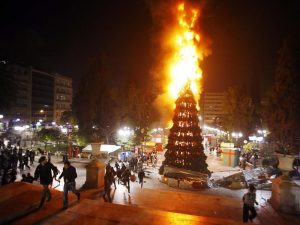
While this short account of the events of the first three days after Alexis’ murder is far from complete or thorough, FYTILI’s incentive is to demonstrate the outbreak of this admittedly unprecedented uprising against state repression. Moreover, the revolt went on anyway with fluctuating intensity for more than a month, experiencing a renewed climax on the 18/01/2009, namely Alexis’ 40-day memorial.
The trial of Korkoneas and Saraliotis
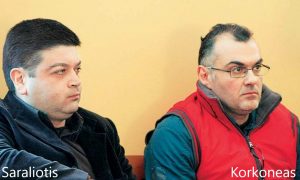
By the time the two special guards were standing in court, the case was already well-known. The public had already formed an opinion on the matter. This resulted, on the one hand, to great mass media coverage and on the other, to a massive wave of rage that was expressed through demos and riots demanding justice, even from a court and judges serving the same corrupt regime that let this murder happen in the first place, and not for the first time. Naturally, the intensity of the above varied from time to time.
Once again, the mass media served a very specific and two-dimensional purpose while reporting about the trial. By continuing the constant and orchestrated vilification against Alexis and his family and simultaneously attempting to morally and honourably acquit the (at the time) accused of their crimes, they tried altering the public opinion on the matter. In addition, the State tried through a series of announcements and actions to affect Alexis’ integrity and undermine the political aspect of the murder, by constantly denouncing his ideas and beliefs and strongly differentiating the ‘angry, violent, dangerous, terrorist mobs’ from the ‘tragically and wrongfully deceased, but overall lost and self-conflicting teenager’. In other words, it was a desperate effort to strip the riots of their meaning.
The already assigned Counsel for the Defendants filed their resignation and were quickly replaced by the infamous Alexis Kougias (Αλέξης Κούγιας), a very experienced and well connected lawyer, among other things, who regularly appears on greek television in order to express his opinion about crucial and current affairs. Kougias’ main tactic during the procedures was to prove that Korkoneas, being a peaceful and respectful individual, had no intent of murdering Alexis, thus guaranteeing him a much milder sentence.
However, the above mentioned publicity and overflow of fake news and vague excuses, combined with the fact that the procedures were open to the public, achieved something that neither the State nor the Mass Media desired. The people got a chance to outline the characters of everyone actively involved in this case. Legal documents, statements, arguments and random conversations were brought to the spotlight.
For example, the content of Korkoneas’ Defence Memorandum, submitted during the Investigation process, was made public. Therein, Korkoneas and his Counsel state that Alexis was the son of a wealthy family living in Palaio Psychiko (wealthy district of Athens), and only visited Exarcheia in order to enjoy its ‘rich’ nightlife that is really appealing to ‘troubled youths’. Furthermore, they claim that Alexis not only was expelled from his previous highschool(Moraitis School) because of unacceptable behaviour, but also took part in some incidents of hooliganism, without providing any sources. The accusations regarding Alexis’ expulsion were refuted by Moraitis School on their official website. The school he was attending at the time (Othisi) openly and officially praised his exceptional ethos and behaviour. No proof that Alexis ever participated at hooligans’ clashes was discovered either.
Moreover,the Defendants’ Counsel kept claiming that the two special guards were acting in self-defence and that Korkoneas never aimed directly at Alexis, but that the last of the allegedly three bullets fired (according to protocol and depending on the weapon’s type, one warning shot and one plastic bullet or two warning shots are required before shooting a normal bullet) ricocheted off the ground and killed him. This accusation was strengthened, according to them, by some early ballistic results and forensics, which showed that the bullet was slightly deformed and did not penetrate all the way through the victim’s body. Although these were presented in front of the court, forensics published later and numerous witnesses’ narrations degraded their evidencial value and proved that Korkoneas was not acting in self-defence.As it turns out, the bullet directly entered Alexis’ body, which excludes the chance of a ricochet and proves that Korkoneas was not aiming at the sky either. The deformation of the bullet might have been a result of its collision with the victim’s bones. It was also proven that he shot twice, disproving his initial statement of following protocol. Meanwhile, Korkoneas’ and Saraliotis’ behaviour inside the courtroom varied from hearing to hearing and their narrations of that night’s events are divergent, unclear and full of contradictions.
Last, but not least, Kougias kept referring to the integrity and morality of Korkoneas, whom he portrayed as a loving father of three minors, living in a poor district in western Athens, a person who loves and supports his family and would never murder a minor for no reason. Korkoneas never honestly apologised for the murder. On the contrary, he has literally stated in 2019: “As if I would apologise to any fifteenyearold”.
Be that as it may, the answer to the disputed question regarding Korkoneas’ character and whether his involvement in the murder was an isolated incident, a black page in the life of an otherwise law-abiding and honest person, is aptly given by his relatives and colleagues. More specifically, he is portrayed as an advocate for a more aggresive conflict stance by the police against anti-authoritarians, and as a generally violence-oriented person, with the nickname “Rambo”. Living up to this name, he allegedly had set his focus on the constant militant ‘struggle’ against revolutionaries in the Exarcheia district, which led to various confrontations with his superiors. In the end even Kougias with his dubious morality had to abandon his defence.
On the 11.10.2010, the mixed Jury Court of first Instance in Amfissa (consisting of three judges and four jurors) found Korkoneas guilty of homicide with direct intention to cause harm, and Saraliotis guilty as an accomplice. Korkoneas was sentenced to life imprisonment and an additional 15 months. Saraliotis was sentenced to 10 years.
In July 2019, following an appeal by the Defendants, Korkoneas’ sentence was reduced to 13 years because of his law-abiding life prior to the murder, which subsequently led to his release from prison, after approximately 10 years of confinement. Saraliotis’ case was reevaluated by the court, and he was found innocent due to the lack of the evidence needed to prove that he was an accomplice. Saraliotis had already been released from prison, having stayed in confinement for 30 months. The State attorney filed a dismissal of the appeal and a further continuation of a trial that has been running for 10 years already, is expected.
Aftermath and consequences
The Murder of Alexis shook the greek society and its ripples are felt throughout the years until today. On behalf of state repression and rhetoric, the riots of the “Black December” sparked new legislation for demonstration regulation, including the so called cowl-law which extends the penalties for the breach of peace – this being the most common accusation during demonstrations – up to ten years from the previous three years or fine, if the person commiting it has covered or distorted facial characteristics. Extended penalties are also included for simple bodily harm, heavy bodily harm, burglary and damage of property, but none as severe. Meanwhile every time the issue of Alexis or rather any issue involving criticism towards the government and its repressive strategies is raised, state officials fall in a fit of whataboutism, avoiding to answer by reproaching their critics for raising one issue above others.

The movement however has experienced a new ‘renaissance’ after Alexis’ murder. In conjuction with the economic crisis that arrived soon after, it has marked the beginning of a new era of raised awareness of the power and the intentions of the state resulting in greater organisation, reinvigoration and expansion within the movement. A large variety of new both monothematic and general groups, squats, collectives and cooperatives sprung into existence. The student movement that directly protested Alexis’ murder played a leading role in this, enabling a larger political discourse in schools and universities and contributing to the formation and evolution of ideals and opinions. As the movement expanded the sense of solidarity as a core pillar of society, unity within the movement, mutual respect and cooperation between groups expanded as well. With strong ideological foundations but also with an emphasis on direct and daily action, anarchy has become a way of life for all that espouse it.
Equally in art, Alexis’ Murder has been a powerful inspiration. From the minimalist monument at the place of his death to the wildly spreading street art, with dozens of mottos, graffiti and stencils in the streets around the world, but especially in Athens. Over the years also, for artists tackling social problems, mainly the problem of repression, be it in theatre, stand-up comedy, painting or most prominently music the name and remembrance of Alexis still echoes. At the end of the article we present a small selection of this art, as a tribute to him and his legacy.
For the rest of society though, this new era did not evoke such a fruitful development. Greece was a society already deeply permeated by traditional and religious values entering a period of economic depression with rising unemployment and poverty in conjunction with the dodging of responsibilites and general incompetence of the political establishment that resulted in increased repression and state sponsored propaganda. This climate certainly pushed many outside of the center of the political spectrum widening the gap between progressives and conservatives, allowing for the Nazi-Party to enter Parliament, but later also for the left Syriza government. Most however remained apolitical and acted on the information they were fed by the sources they trusted.

Accordingly, matters of social struggle and state oppression were viewed through each respective lens with little consideration of the interests behind it and with the minimum of critical thought. As such, while Alexis’ murder and its immediate aftermath was quickly forgotten by some, it was an awakening to many at the beginning of this era, and to equally many others just the beginning of a series of disruptions of society, perpetrated by individuals thriving on chaos and violence. In any case we feel that this one event has indeed shaped an entire generation.
Epilogue
Goal of this text is to demonstrate how the violence and the general outburst of the Black December were a necessary and indispensable consequence of a crime, a murder, commited by the state through the hands of one of its executing functionaries. The murder of Alexis was not an isolated incident, caused by one twisted individual. It wasn’t commited in hot blood, nor was the State against it. It was political, terroristic (because only the State uses the spread of terror as political means) and very well architected. This is the reason why Korkoneas’ contrition is not only impossible, but also irrelevant, because the target was not Alexandros Grigoropoulos as a being specifically, but the ideology, ethics and morality ‘he and his people’ had and still have. 23 years after the scandalous murder of another boy Michalis Kaltezas (Μιχάλης Καλτεζάς) by police, the Greek state refreshed the already existing certainty in the Greek society that it is a dangerous, repressive, vicious, murderous and corrupt construct.
Murders by police are not a ‘Greek speciality’ though. Alexis stands in a very long international list of victims, like Berkin Elvan and Carlo Giuliani, just to name a couple, and unites the movements of Greece and the world against their true enemy: state violence and repression. With Alexis’ murderers set free by the ‘liberal democracy’, the urge to show them that we don’t forget is more than eruptive. As many other victims’, Alexis’ vindication is still pending. This whole situation concerns not 10, not 100, but thousands of people. The 100 protesters of Friday the 4th gave everyone courage in advance of the culmination on Sunday the 6th, the actual anniversary of Alexis’ murder, a day not only for memory but much more for the current social struggle against the new wave of state repression. The previous misconduct of police forces in the past few months under the veil of the COVID-19 pandemic leads us to the safe conclusion that there will be much more to report and discuss on, which will be done(from our side) through a new text in the near future. Not to worry though. No matter how much they try to marginalise and silence us, “it is we who are going to say the last word, because these are the days of Alexis”.
ΕΜΕΙΣ ΘΑ ΠΟΥΜΕ ΤΗΝ ΤΕΛΕΥΤΑΙΑ ΛΕΞΗ, ΑΥΤΕΣ ΟΙ ΜΕΡΕΣ ΕΙΝΑΙ ΤΟΥ ΑΛΕΞΗ
Gallery
The Monument

General View

The inscription on the marble slab: To the memory of little Alexandros. He was only 15 years old. 6th of December 2008.

The inscription on the wall: Here on the 6th of December 2008, with no reason at all, the children’s smile of the innocent fifteen-year-old Alexandros Grigoropoulos was extinguished by the bullets of impenitent murderers.
Stencils

Portrait

“Greece eats its children”
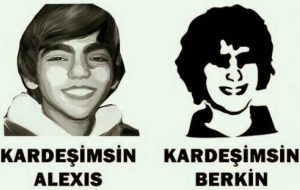
The “brothers” Alexis Grigoropoulos and Berkin Elvan
Straßenkunst – Street Art

Graffiti von blu in einem besezten Gebäude in Rom – A graffiti of blu on a squat in Rome
Skizzen – Sketches
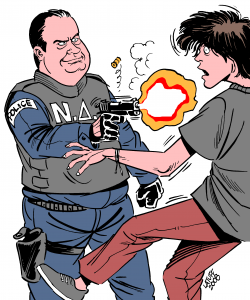
Sketch by Carlos Latuff from the 8th of December 2008 depicting the then greek prime minister in a police uniform bearing the initials of the ruling party shooting at Alexis

Sketch on the title page of the magazine “Paroxysmos” from March 2014 depicting three symbolical figures for the era: (right) The boy who was murdered by the police, Alexis Grigoropoulos, signaling the beginning of the era, (left) Shehzad Luqman, whose murder by the Nazis of the Golden Dawn brought to light countless other cases of violence against Immigrants and (center) Pavlos Fyssas, the antifascist Rapper, whom the Nazis executed with the toleration of the police. His murder showed the widespread dissemination of and tolerance for right-wing extremism in greek society and lead, after a lengthy court process, to the declaration of the Nazi-Party “Golden Dawn” as a criminal organisation on the 7th of October 2020.
Paintings

A modern abstract painting by Stelios Zacharoudis
Music
We would very much like to translate the song lyrics, but such translations would be extremely bland due to the different structures and nuances of the language used and thus would in no way be as representative of the emotions and ambience of these songs as we would want, so we instead try to only briefly summarise their content.
Οργή – Rage
An adaptation of the french song “La Rage” by the Band Methismena Xotika. It describes the warlike atmosphere of the riots that followed the murder of Alexis, directly criticises the bystander for not participating and calls them to pick a side.
Εκτός Ελέγχου – Out of Control
A song by Killah P (Pavlos Fyssas) in cooperation with other rappers. It paints the picture of the pathologies, decay and putrefaction of the society that lead to the death of Alexis, and how the situation has since only worsened.
Πρίγκιπες – Princes
A song by the Band Archanthropoi. Taking a nickname, Prince, that the friends of Alexis had for him the song tells the story of the Murder from his point of view. He then predicts, that his death will caus the awakening of his whole generation.
Οι νύχτες του Αλέξη – The nights of Alexis
It describes the timelessness of repression and how every Alexis gives rise to resistance against it for all the oppressed.
Ματωμένη Βροχή – Bloody Rain
A song by Pavlos Synodinos for the 10-year-anniversary of the murder of Alexis. It is more or less a lament for the irreversible moment of the “murder” of two boys, Alexis who was litteraly murdered and his friend Romanos, whose Life was destroyed in that Moment. The bloody rain is a metaphore for all that followed.
Η αρχή και το τέλος – The beginning and the end
A song by the Rapper Komis X from this year’s anniversary. Trying to understand how and why it happened, it describes the murderer‘s train of thought, how he fluctuates between arrogance and regret. The song then culminates with the voices of the wrath of the “Erinnyes”, namely the people that are still here, bringing him to face his guilt.
Sources
General
A good overview from the german indymedia site
A greek documentary film
A surprisingly good overview with many more sources from the greek and english Wikipedia pages
The night of the murder
The account of Nikos Romanos
The first reactions
audiovisual material: [1] , [2] , [3] , [4]
Panagiotopoulos’ account on the distortion of L.V.’s video
The trial of Korkoneas and Saraliotis
A comment on the proceedings by Nikos Romanos
Various sources: [1] , [2] , [3] , [4] , [5] , [6] , [7] , [8] , [9] , [10] , [11] , [12] , [13]





